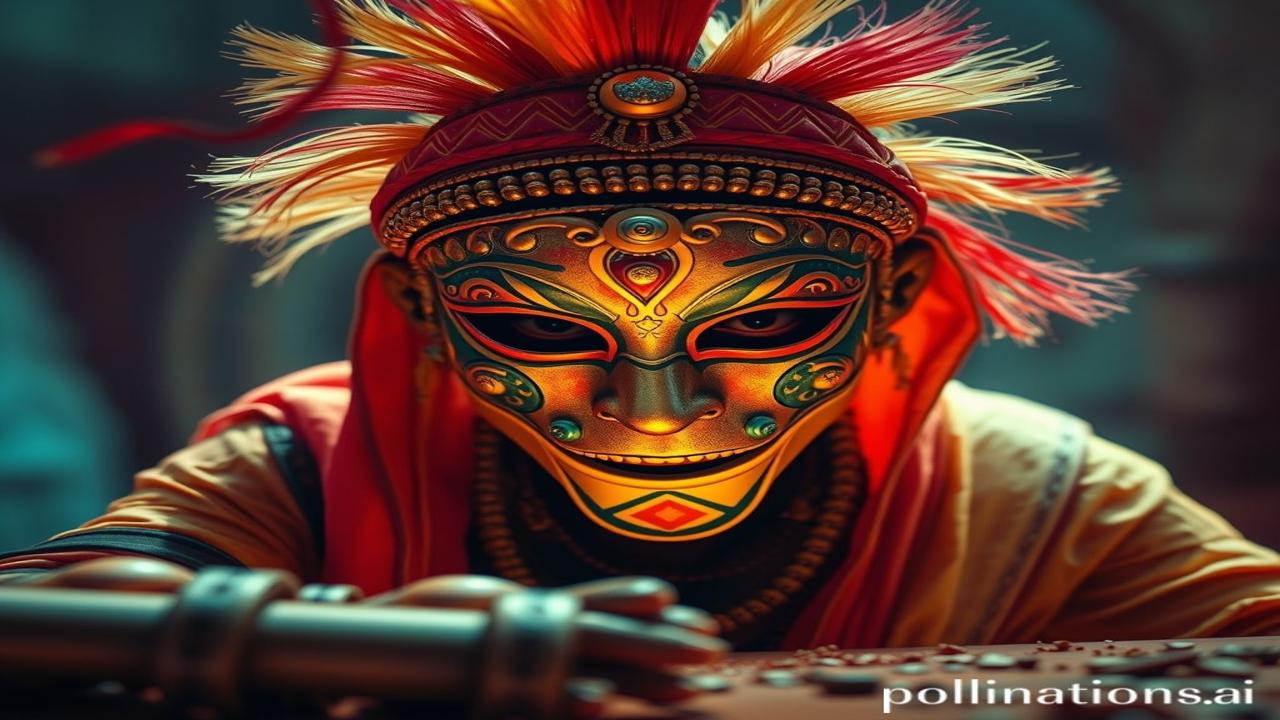Chehre Ke Peeche Chehra: Mask Making and Performance – Ek Anokhi Kahani
Kabhi dekha hai ek aaina jo aapko nahin, kisi aur ko dikhaye? Imagine walking down a dusty street in ancient India, the air thick with incense and the rhythmic beat of drums. Suddenly, a masked figure emerges, their eyes blazing with power, transporting you to a world of gods and demons. This is the magic of masks and performance – a tradition that has breathed life into stories for millennia.
Itihasik Prishthbhumi / Historical & Cultural Context
Masks aren’t just Halloween costumes; they are potent symbols, steeped in history and cultural significance. From the tribal rituals of ancient India to the elaborate theatre of the Mughal court, masks have been used to communicate with the divine, to embody spirits, and to entertain and educate.
What is it? Mask making and performance is a multi-faceted art form combining sculpture, painting, storytelling, music, and dance. It’s a way to transcend the ordinary and enter a realm of myth and legend.
When and where did it happen or originate? The roots of this practice go deep, dating back to pre-Vedic times. Archaeological evidence suggests that masks were used in religious ceremonies and dances in the Indus Valley Civilization (around 3300-1700 BCE). Over time, different regions of India developed their own unique mask-making traditions, each reflecting the local folklore and beliefs. For example, the Chhau dance of Eastern India and the Theyyam rituals of Kerala are renowned for their elaborate masks and costumes.
Why is it important in our history or culture? Masks offer a tangible connection to our ancestors and their beliefs. They are a powerful tool for preserving and transmitting cultural knowledge across generations. Think about Ramlila performances during Dussehra – the masks of Ravana and Hanuman instantly transport audiences to the epic tale of the Ramayana. This is more than just entertainment; it’s a living tradition, a vital thread in the fabric of our Bharatiyata.
Zameeni Sach – Log aur Jeevan / Deep Dive with Human Element
Imagine, a potter named Bhima, in a small village in Rajasthan, centuries ago. His hands, weathered and strong, would mould the clay with reverence, creating masks of local deities. He would spend days, meticulously painting each detail, infusing the mask with shakti. His wife, Devi, would sew intricate costumes, adorned with mirrors and vibrant fabrics. Their children would help, learning the stories and songs associated with each mask.
“Bhima, yeh Hanuman ki aankhein thodi aur tez honi chahiye,” Devi would say, her voice gentle but firm. “Unki shakti dikhni chahiye!”
Bhima would nod, his brow furrowed in concentration. “Haan, Devi. Tum sahi kehti ho. Hanuman toh bal aur bhakti ka pratik hain.”
These masks weren’t mere objects; they were vessels of power, imbued with the hopes, fears, and dreams of the community. They were used in rituals to ward off evil spirits, to celebrate harvests, and to connect with the divine.
Dharohar aur Pehchaan / Cultural Significance Today
Even today, in the age of smartphones and social media, the tradition of mask making and performance endures. From the vibrant Bhaona performances of Assam to the intricate Koodiyattam theatre of Kerala, these art forms continue to captivate and inspire.
We see glimpses of this ancient art in our festivals, in our folk dances, and even in contemporary theatre. The use of masks in street plays to address social issues demonstrates the continued relevance of this art form as a tool for communication and change. The kala of mask making is a living testament to the resilience and creativity of the Indian spirit.
Mazedaar Tathya ya Bhram-Bhanjak / Fun Fact or Myth-Buster
Log samajhte hain ki masks sirf mazaak ke liye hote hain. (People think masks are just for fun). Lekin asli sach yeh hai (But the real truth is) that masks were often used in serious rituals and ceremonies, representing deities, spirits, or even ancestors. They were believed to possess the power to transform the wearer and connect them with the supernatural realm.
Did you know that some masks were considered so sacred that only certain individuals were allowed to handle them? Breaking these rules could lead to dire consequences, according to local beliefs!
Drishya aur Bhavnayein / Visual & Sensory Layer
Imagine the scent of freshly baked clay mingling with the aroma of sandalwood incense. Feel the smooth, cool surface of a mask under your fingertips. Hear the rhythmic beat of the drums, the chanting of mantras, and the rustling of silk costumes. The vibrant colors of the masks – crimson red, ochre yellow, emerald green – explode before your eyes, transporting you to a world of myth and magic.
Antim Vichar ya Uddharan / Closing Insight or Quote
“Yada yada hi dharmasya glanir bhavati bharata,
Abhyutthanam adharmasya tadatmanam srjamy aham.”
(Whenever there is a decline in righteousness and an upsurge in unrighteousness, O Arjuna, at that time I manifest Myself.)
Like the masks that embody the eternal struggle between good and evil, the spirit of India continues to adapt and evolve, preserving its ancient traditions while embracing the future. The art of mask making and performance is a powerful reminder that behind every face, there lies a story waiting to be told.
